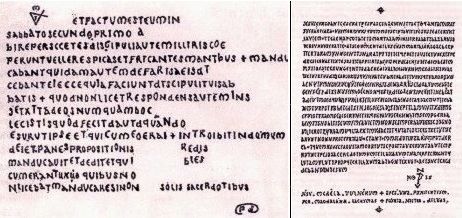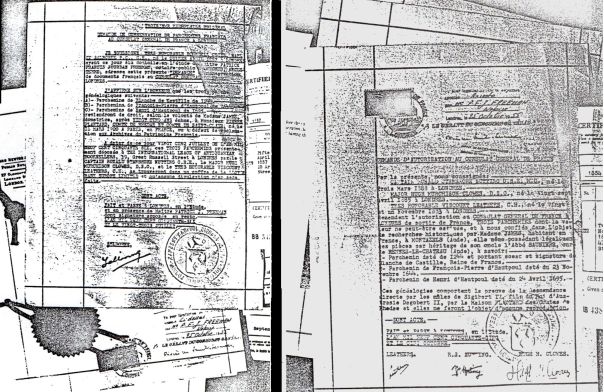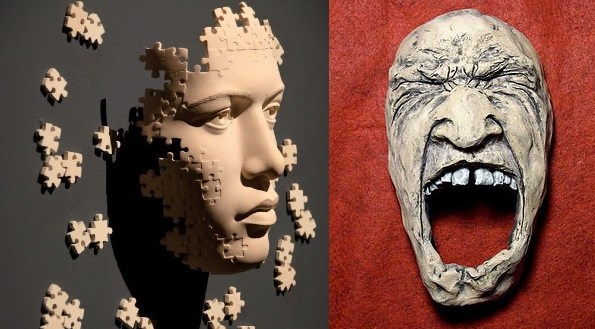The Facts about the “Parchments”
The Story of a False History
A. Gilmore-Thabot
21 January 2024
Updated 26 January 2024
Let's forget about dealing with the Labyrinthine Maze of Mystification that is found in the latest essay “Pour en finir avec le Codex Beza par François Lange (17 janvier 2024)”.
Let's instead concentrate on the provable facts.

The two well-known “parchments” first originated within the context of Pierre Plantard and Philippe de Chérisey, in the work attributed to Madeleine Blancasall in 1965 (page 5), a few years before they first appeared in Gérard de Sède's book, “L'Or de Rennes” (pages 133 & 135, 1967). An interesting fact, the deciphered message to the Large Parchment was revealed – its decoding could only have been known by the creator of the Large Parchment and absolutely no-one else. In other words, it is not a “decryption” in the normal sense of the word.
The intention of the two “parchments” were to buttress the survival of the Merovingian Kings of France and, during this period of time, Pierre Plantard claimed to be the direct descendant. The son of King Dagobert II had allegedly survived and skipped from France and had survived in Septimania. A set of poorly forged genealogies at the back of the work attributed to Madeleine Blancassall purported to support this far-fetched conspiracy theory.
Gérard de Sède's book, “L'Or de Rennes” tantalisingly teased the reader into believing there had to be something to “the mystery of Rennes-le-Château” and de Sède reproduced the two “parchments” in his book (that, after all, were allegedly discovered by Abbé Bérenger Saunière, according to their story). One of the “parchments” explicitly referred to Dagobert II. Such is the context in which the “parchments” first originated. The “parchments” originally served as prime evidence for Pierre Plantard's myth – that he was the direct descendant of the Merovingian Kings of France and that the son of Dagobert II lived on to survive in Rennes-le-Château and to form his own dynasty.
However, all was not well with Pierre Plantard, Philippe de Chérisey and Gérard de Sède. The contract of “L'Or de Rennes” included the signature of Pierre Plantard, who was due some of the book's profits (Pierre Plantard actually claimed in 1979 that Gérard de Sède was originally due 35% of the royalties, because Plantard claimed he was the main author). But Gérard de Sède refused to give Pierre Plantard his share of the profits. A similar thing happened with Gérard de Sède's earlier book “Les Templiers sont parmi nous, ou, L'Enigme de Gisors” (1962). Pierre Plantard's name was on the contract of that book as well, and again de Sède did not give Plantard his full share of royalties.
Therefore Pierre Plantard and Philippe de Chérisey had every right to feel outraged and denounce Gérard de Sède – and to call the two “parchments” forgeries – since they turned out to be the main selling-point of his book “L'Or de Rennes”. Pierre Plantard and Philippe de Chérisey forged the “parchments” and Gérard de Sède was reaping all the financial rewards. Philippe de Chérisey even wrote a letter of protest to a solicitor in Paris.
In 1979, a document in the Bibliotheque Nationale was deposited called “Pierre Plantard de Saint-Clair: MISE AU POINT. Repond a Pierre Pons.” The document may be regarded as suspicious due to the fact that the purported information concerning the publishing details of “L’Or de Rennes” were unknown prior to 1979. However, no serious researcher has analysed or double-checked the validity (or otherwise) of the document’s contents. Pierre Plantard was good at obtaining original official documents and doctoring them to suit his nefarious purposes (eg, The League of Antiquarian Booksellers).
The next stage were the British BBC 2 “Chronicle” documentaries of the 1970s. During production Philippe de Chérisey repeated that he had created the “parchments”. No-one took any notice of him. The “Chronicle” documentaries were however, a major scoop for Pierre Plantard, his being given an opportunity to give an interview on BBC television to repeat his canards.
The next stage was author Jean-Luc Chaumeil. Pierre Plantard gave him the two “original parchments” of which Gérard de Sède had received only photocopies of. Plantard wanted Chaumeil to publish them in a book. Plantard wanted to use Chaumeil as a weapon against Gérard de Sède. At the same time, Philippe de Chérisey wanted to deposit in the Bibliotheque Nationale his manuscript “Stone and Paper” – but Plantard decided against it, hoping that Chaumeil's book would serve his purpose.
However, Jean-Luc Chaumeil rejected the idea of publishing the two “parchments” and instead opted for a “Bermuda Triangle” style theory of Gisors, Stenay and Rennes-le-Château (“Le trésor du Triangle d'Or”, 1979).
The next stage for Pierre Plantard and Philippe de Chérisey was to use the author Louis Vazart. Two “Secret Documents” pertaining to “secret genealogies relating to the survival of the son of King Dabobert II, discovered by Abbé Saunière”, were published by Vazart in his book “Dagobert II et le mystère de la cité royale de Stenay” (pages 040 & 041, 1983).

These two “Secret Documents” gave Michael Baigent, Richard Leigh and Henry Lincoln the opportunity to gatecrash the party by using them as the substance to their next book “The Messianic Legacy” (1986) – to give their version of the Priory of Sion (involving the Guardian Assurance Company). It was also in “The Messianic Legacy” (chapter 22) that Plantard’s Vichyite past was revealed (ultimately – and wrongly – rejected by the three authors).
I have it on good authority from someone who met Jean-Luc Chaumeil in Paris in September 1982 – that Chaumeil showed him the Secret Service Reports of the French Police – that revealed Pierre Plantard was a supporter of Vichy and had edited a pro-Vichyite version of “Vaincre”. (During the 1940s Pierre Plantard was known as “His Druidic Majesty” rather than the direct lineal descendant of King Dagobert II.)
It was sometime after the publication of “The Messianic Legacy” in 1986 that Pierre Plantard broke off from the three authors and later formed his revised version of the Priory of Sion with a completely different pedigree to that found in “Les Dossiers Secrets” – who Plantard said was composed by Philippe Toscan du Plantier who was arrested for taking LSD. Philippe Louis Gerard Toscan du Plantier (1937-2000) undoubtedly existed – the real question is: did he know anything about Pierre Plantard and his “Priory of Sion” – or was his name simply “pulled out of a hat” by Pierre Plantard.
That had an effect on Michael Baigent, Richard Leigh and Henry Lincoln. Baigent & Leigh started writing books on other subject matters. Henry Lincoln started writing about Sacred Landscape Geometry (inspired by David Wood, whose lectures he attended at his home, but writing the manuscript for the book that was to become entitled “The Holy Place” kept a secret from David Wood).
The point is this: Pierre Plantard dropped the authenticity of the “two parchments” a very long time ago in 1967 after Gérard de Sède took his share of the royalties after “L'Or de Rennes” was published – and afterwards always cited the existence of other “parchments” (eg, those belonging to Madame James in “Le cercle d'Ulysse”, pages 2-3, attributed to Jean Delaude, 1977).
The story about Madame James is interesting – because shortly after the story appeared in 1977 in “Le Cercle d’Ulysse”, Pierre Plantard wrote in 1979 the following: “In 1955 my uncle bought from Madame JAMES the three parchments discovered by Abbé SAUNIÈRE, the parish priest of Renne-le-Château. These documents have now been in the safe of an English bank for some 24 years.” One of the people involved as given in “Le Cercle d’Ulysse” was named as Sir Thomas Frazer (the other was “Captain Ronald Stansmore” who turned out to be Captain Arthur Ronald Stansmore Nutting). The only son of Sir Thomas Frazer (deceased) was contacted by a researcher about this story – he replied that he was totally ignorant of the whole situation – he contacted his solicitor whose enquiries with Lloyds Bank were totally negative. Michael Baigent was informed about this and shortly afterwards the “Secret Documents” in Louis Vazart's 1983 book appeared with the name Sir Thomas Frazer omitted – but with the (full) name of Captain Ronald Stansmore Nutting still added.
Now, more than several decades later, people are still addicted to the non-existent “parchments” – dreaming-up all sorts of reasons and excuses to make it all a scientific and technical subject matter – the more cerebral the better. These “experts” do not acknowledge that the “parchments” first existed in a Priory of Sion work dating from 1965. These “experts” shun the existence of the correspondence between Pierre Plantard and Philippe de Chérisey who wrote about the “parchments” – instead relying on the figments of their own imaginations. The same thing applies to other subject matters as well – everything from the Knights Templar to Ancient Egypt to Flying Saucers. The days of taking Rennes-le-Château seriously by many finished decades ago because of the types of people the subject matter attracts. And was there really a “mystery” to begin with?

|


